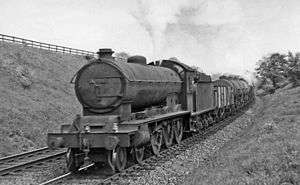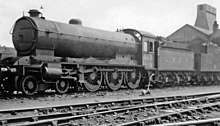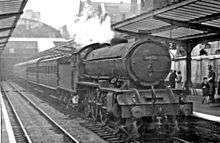NER Class S3
The North Eastern Railway Class S3, classified B16 by the LNER, was a class of 4-6-0 steam locomotive designed for mixed traffic work. It was designed by Vincent Raven and introduced in 1920. The earlier members of this class were fitted with Westinghouse Brakes - all of this equipment was removed during the 1930s.
| NER Class S3 LNER Class B16 | |||||||||||||||||||||||||||||||||||||||||||||||||
|---|---|---|---|---|---|---|---|---|---|---|---|---|---|---|---|---|---|---|---|---|---|---|---|---|---|---|---|---|---|---|---|---|---|---|---|---|---|---|---|---|---|---|---|---|---|---|---|---|---|
 No. 61469 at Croxdale 12 June 1954 | |||||||||||||||||||||||||||||||||||||||||||||||||
| |||||||||||||||||||||||||||||||||||||||||||||||||
| |||||||||||||||||||||||||||||||||||||||||||||||||
| |||||||||||||||||||||||||||||||||||||||||||||||||
| |||||||||||||||||||||||||||||||||||||||||||||||||
Post-NER
Seventy S3/B16 locomotives were built between 1919 and 1924. The NER began numbering this class in the range No. 840 through to No. 943 (though not contiguously), those built after late 1922 (from No. 2363 onwards) directly receiving their LNER number. In 1923 all seventy locomotives passed to the London and North Eastern Railway (LNER). Some of the existing members were subsequently rebuilt, as shown below (the initially built locomotives being re-designated class B16/1. Seven were rebuilt by Gresley, becoming class B16/2 and seventeen, by Thompson, designated class B16/3). Under the LNER re-numbering scheme, of 1946, they received numbers 1400-1468. Sixty-nine passed into British Railways ownership in 1948 and they were again re-numbered in the sequence 61400-61478. (Numbers 61400 to 61409 were directly re-numbered as 61469 to 61478). One locomotive, No. 925, was badly damaged (along with A4 4469 Sir Ralph Wedgwood) during a German air-raid on York, 29 April 1942 and was subsequently scrapped. The last, of any variety of B16, was scrapped in 1964 and none have been preserved.
Sub-classes


- B16/1 Introduced 1920, NER design by Vincent Raven with inside Stephenson valve gear.
- B16/2 Introduced 1937, LNER rebuild of B16/1 by Nigel Gresley with Walschaerts valve gear on the outside cylinders and Gresley conjugated valve gear on the inside cylinder.
- B16/3 Introduced 1944, LNER rebuild of B16/1 by Edward Thompson with three sets of Walschaerts valve gear.
Accidents and incidents
- On 27 June 1928, locomotive No. 2369 was involved in a head-on collision with an excursion train at Darlington, County Durham whilst it was shunting a parcels train. Twenty-five people were killed and 45 were injured.[1]
- On 5 January 1946, locomotive No. 842 was hauling a freight train which became divided on the East Coast Main Line in County Durham. The train was brought to a halt at Browney Signalbox, but the rear portion crashed into it. The wreckage fouled signal cables, giving a false clear to a passenger train coming in the opposite direction. This train then collided with the wreckage. Ten people were killed and eight were severely injured.[2]
References
- Hoole, Ken (1982). Trains in Trouble: Vol. 3. Redruth: Atlantic Books. pp. 27, 35. ISBN 0-906899-05-2.
- Earnshaw, Alan (1991). Trains in Trouble: Vol. 7. Penryn: Atlantic Books. ISBN 0-906899-50-8.
- Source
- Ian Allan ABC of British Railways Locomotives, part 4 (1948 ed.). p. 10.